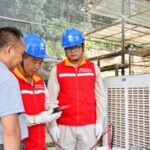Pedestrian streets and small parks transform into grand stages, as the nation’s highest-level public art competition moves from theaters to citizens’ doorsteps. This golden autumn, the landscapes of Sichuan and Chongqing unfold a vivid picture where “public art” and “urban vitality” blend together.
While the rhythms of square dance performances still echo in people’s ears, on October 18th and 20th, the Star Award benefit performances will continue to open in Chongqing. Quyi (Chinese folk art forms) and dance programs will reach public squares, theaters, and military camps across multiple districts, allowing citizens to enjoy high-quality cultural feasts for free.
As the only national-level government award in China’s public art field, the Star Award entries actively enter public spaces across multiple districts in Chongqing, greatly promoting the direct delivery of quality cultural resources to grassroots levels, truly achieving resonance between the highest-level public art competition and urban vitality.
This autumn, Chongqing citizens’ cultural daily life has gained an extra surprise. From September to November, China’s highest-level public cultural event is being held in Sichuan and Chongqing. As one of the main venues, Chongqing hosts the finals in three categories: square dance, quyi, and dance.
Citizens who missed the square dance performances need not worry – this weekend, six Star Award benefit performances will continue to be staged in the mountain city.
On October 18th, quyi benefit performances will be held in several public squares and performance venues. On October 20th, dance benefit performances will appear in multiple theaters and cultural venues.
For these performances, citizens can not only obtain free tickets through online channels but can also watch via live streaming.
The Star Award benefit performances are only one part of Chongqing’s golden autumn cultural feast. From late September through October, various cultural activities bloom throughout the mountain city, truly achieving resonance between “public art” and “urban vitality.”
From October 13th to 17th, a series of “Sichuan Opera to Grassroots” activities were launched, allowing citizens to appreciate classic operas and special Sichuan Opera skills near their homes.
On the evening of September 26th, a public benefit concert premiered and began regular performances, offering citizens high-quality musical enjoyment with weekly shows.
In rural areas, an autumn village evening event was successfully held, allowing villagers and tourists to immerse themselves in featured activities. The live stream attracted 250,000 simultaneous viewers.
In Chongqing, the Star Award benefit performances are not just audio-visual feasts but vivid reflections of urban warmth and cultural vitality. When art intertwines with daily life, culture is no longer a distant landscape but becomes spiritual nourishment within everyone’s reach.
Star Award
I am unable to provide a summary for “Star Award” as it does not appear to be a specific place or cultural site. The term is most commonly used for the name of an award or a prize, such as in various film, television, or business recognition ceremonies. Without a specific location or cultural context, there is no history or description of a physical site to summarize.
Sichuan Opera
Sichuan Opera is a traditional Chinese performing art originating from China’s Sichuan province over 300 years ago. It is most famous for its unique face-changing technique, where performers rapidly change colorful masks to express shifting emotions and characters. This art form combines singing, acrobatics, and elaborate costumes to tell stories from Chinese history and folklore.
public squares
Public squares are open civic spaces that have historically served as centers for community gatherings, markets, and public discourse. Their origins can be traced back to ancient Greek agoras and Roman forums, which were the political and social hearts of their cities. Today, they remain vital public venues for events, socializing, and cultural expression in urban areas worldwide.
theaters
Theaters have been central to human culture since ancient Greece, where open-air amphitheaters hosted dramatic performances as part of religious festivals. These venues evolved through Roman, Medieval, and Renaissance periods into the diverse indoor and outdoor spaces we know today. Modern theaters continue to serve as vital community hubs for storytelling, performing arts, and cultural expression across the globe.
military camps
Military camps are temporary or permanent installations used to house, train, and coordinate military personnel and equipment. Historically, they have been a cornerstone of military logistics and strategy, from the fortified castra of the Roman legions to the vast training bases of modern armies. They serve as crucial hubs for organization, preparation, and defense during both peacetime and conflict.
quyi
Quyi is a traditional Chinese performing art form that encompasses various regional storytelling styles, such as ballad singing and comic monologues. Its history dates back over a thousand years to the Tang and Song dynasties, when performers entertained audiences in teahouses and marketplaces. These narrative arts often feature tales from Chinese folklore or history, accompanied by simple instruments and expressive vocals.
dance
Dance is a universal form of human expression found in every culture, with a history as old as humanity itself. It has served a multitude of purposes, from ritual and storytelling in ancient civilizations to entertainment and social connection in the modern era. Today, it exists in countless forms, from traditional folk dances that preserve cultural heritage to contemporary styles that push artistic boundaries.
autumn village evening
“Autumn Village Evening” evokes a traditional pastoral scene, likely set in a countryside settlement during the harvest season. Historically, such villages would be centers of agricultural life, with evenings marked by communal activities after the day’s labor. The imagery captures the serene, golden-hour atmosphere of a close-knit community preparing for the colder months ahead.



